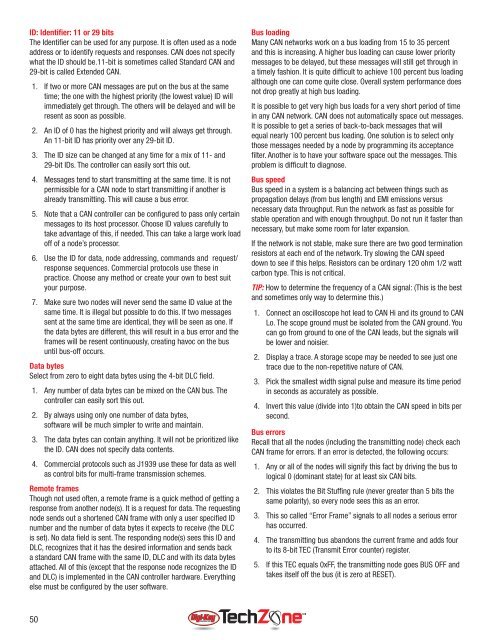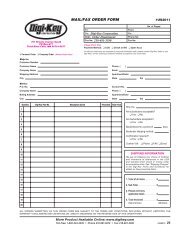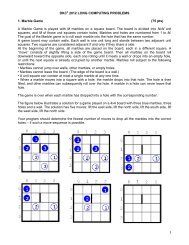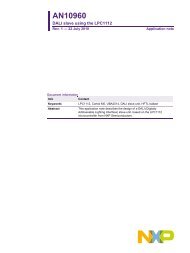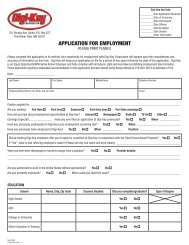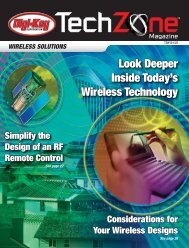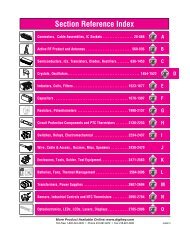Microcontroller Solutions TechZone Magazine, April 2011 - Digikey
Microcontroller Solutions TechZone Magazine, April 2011 - Digikey
Microcontroller Solutions TechZone Magazine, April 2011 - Digikey
You also want an ePaper? Increase the reach of your titles
YUMPU automatically turns print PDFs into web optimized ePapers that Google loves.
ID: Identifier: 11 or 29 bits<br />
The Identifi er can be used for any purpose. It is often used as a node<br />
address or to identify requests and responses. CAN does not specify<br />
what the ID should be.11-bit is sometimes called Standard CAN and<br />
29-bit is called Extended CAN.<br />
1. If two or more CAN messages are put on the bus at the same<br />
time; the one with the highest priority (the lowest value) ID will<br />
immediately get through. The others will be delayed and will be<br />
resent as soon as possible.<br />
2. An ID of 0 has the highest priority and will always get through.<br />
An 11-bit ID has priority over any 29-bit ID.<br />
3. The ID size can be changed at any time for a mix of 11- and<br />
29-bit IDs. The controller can easily sort this out.<br />
4. Messages tend to start transmitting at the same time. It is not<br />
permissible for a CAN node to start transmitting if another is<br />
already transmitting. This will cause a bus error.<br />
5. Note that a CAN controller can be confi gured to pass only certain<br />
messages to its host processor. Choose ID values carefully to<br />
take advantage of this, if needed. This can take a large work load<br />
off of a node’s processor.<br />
6. Use the ID for data, node addressing, commands and request/<br />
response sequences. Commercial protocols use these in<br />
practice. Choose any method or create your own to best suit<br />
your purpose.<br />
7. Make sure two nodes will never send the same ID value at the<br />
same time. It is illegal but possible to do this. If two messages<br />
sent at the same time are identical, they will be seen as one. If<br />
the data bytes are different, this will result in a bus error and the<br />
frames will be resent continuously, creating havoc on the bus<br />
until bus-off occurs.<br />
Data bytes<br />
Select from zero to eight data bytes using the 4-bit DLC fi eld.<br />
1. Any number of data bytes can be mixed on the CAN bus. The<br />
controller can easily sort this out.<br />
2. By always using only one number of data bytes,<br />
software will be much simpler to write and maintain.<br />
3. The data bytes can contain anything. It will not be prioritized like<br />
the ID. CAN does not specify data contents.<br />
4. Commercial protocols such as J1939 use these for data as well<br />
as control bits for multi-frame transmission schemes.<br />
Remote frames<br />
Though not used often, a remote frame is a quick method of getting a<br />
response from another node(s). It is a request for data. The requesting<br />
node sends out a shortened CAN frame with only a user specifi ed ID<br />
number and the number of data bytes it expects to receive (the DLC<br />
is set). No data fi eld is sent. The responding node(s) sees this ID and<br />
DLC, recognizes that it has the desired information and sends back<br />
a standard CAN frame with the same ID, DLC and with its data bytes<br />
attached. All of this (except that the response node recognizes the ID<br />
and DLC) is implemented in the CAN controller hardware. Everything<br />
else must be confi gured by the user software.<br />
Bus loading<br />
Many CAN networks work on a bus loading from 15 to 35 percent<br />
and this is increasing. A higher bus loading can cause lower priority<br />
messages to be delayed, but these messages will still get through in<br />
a timely fashion. It is quite diffi cult to achieve 100 percent bus loading<br />
although one can come quite close. Overall system performance does<br />
not drop greatly at high bus loading.<br />
It is possible to get very high bus loads for a very short period of time<br />
in any CAN network. CAN does not automatically space out messages.<br />
It is possible to get a series of back-to-back messages that will<br />
equal nearly 100 percent bus loading. One solution is to select only<br />
those messages needed by a node by programming its acceptance<br />
fi lter. Another is to have your software space out the messages. This<br />
problem is diffi cult to diagnose.<br />
Bus speed<br />
Bus speed in a system is a balancing act between things such as<br />
propagation delays (from bus length) and EMI emissions versus<br />
necessary data throughput. Run the network as fast as possible for<br />
stable operation and with enough throughput. Do not run it faster than<br />
necessary, but make some room for later expansion.<br />
If the network is not stable, make sure there are two good termination<br />
resistors at each end of the network. Try slowing the CAN speed<br />
down to see if this helps. Resistors can be ordinary 120 ohm 1/2 watt<br />
carbon type. This is not critical.<br />
TIP: How to determine the frequency of a CAN signal: (This is the best<br />
and sometimes only way to determine this.)<br />
1. Connect an oscilloscope hot lead to CAN Hi and its ground to CAN<br />
Lo. The scope ground must be isolated from the CAN ground. You<br />
can go from ground to one of the CAN leads, but the signals will<br />
be lower and noisier.<br />
2. Display a trace. A storage scope may be needed to see just one<br />
trace due to the non-repetitive nature of CAN.<br />
3. Pick the smallest width signal pulse and measure its time period<br />
in seconds as accurately as possible.<br />
4. Invert this value (divide into 1)to obtain the CAN speed in bits per<br />
second.<br />
Bus errors<br />
Recall that all the nodes (including the transmitting node) check each<br />
CAN frame for errors. If an error is detected, the following occurs:<br />
1. Any or all of the nodes will signify this fact by driving the bus to<br />
logical 0 (dominant state) for at least six CAN bits.<br />
2. This violates the Bit Stuffi ng rule (never greater than 5 bits the<br />
same polarity), so every node sees this as an error.<br />
3. This so called “Error Frame” signals to all nodes a serious error<br />
has occurred.<br />
4. The transmitting bus abandons the current frame and adds four<br />
to its 8-bit TEC (Transmit Error counter) register.<br />
5. If this TEC equals 0xFF, the transmitting node goes BUS OFF and<br />
takes itself off the bus (it is zero at RESET).<br />
50


